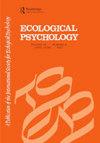Effects of Surface Luminance and Texture Discontinuities on Reachableness in Virtual Reality
IF 1.7
3区 心理学
Q3 PSYCHOLOGY, EXPERIMENTAL
引用次数: 6
Abstract
Abstract Perceiving distance is at the heart of everyday actions like reaching for a cup of coffee. This action depends on at least the biomechanical restrictions of the actor (i.e., arm-length) and the physical distance between the cup and the actor. Environmental variables may also impact perceived distances for reaching. For a given perceptual judgment, these variables might be thought of as static, i.e., stable or unchanging. But the perception-action process involves the unfolding of dynamic variables such as exploratory movement. Four experiments were conducted to investigate the roles of two “static” environmental variables (surface luminance and surface texture discontinuity) and two “dynamic” exploratory-movement-related variables (mean head displacement and multifractality of head movement) in an object-reachableness task in virtual reality. We found that surface texture discontinuities and surface luminance can make objects appear more reachable, but not always. We also found that in more complex scenarios, the inclusion of the dynamic variables improved model fits over the static models. We suggest that movement is the driver of perception and, that in attempting to model a given perceptual process, the researcher must consider the underlying characteristics of variables tested and seek out variables related to the unfolding dynamics of the perception-action cycle.虚拟现实中表面亮度和纹理不连续性对可达性的影响
感知距离是日常行为的核心,比如伸手去拿一杯咖啡。这一动作至少取决于参与者的生物力学限制(即臂长)和杯子与参与者之间的物理距离。环境变量也可能影响到达的感知距离。对于给定的感知判断,这些变量可能被认为是静态的,即稳定或不变。但感知-行动过程涉及到探索运动等动态变量的展开。通过四个实验研究了两个“静态”环境变量(表面亮度和表面纹理不连续)和两个“动态”探索运动相关变量(平均头部位移和头部运动的多重分形)在虚拟现实中物体可达性任务中的作用。我们发现表面纹理不连续性和表面亮度可以使物体看起来更容易到达,但并非总是如此。我们还发现,在更复杂的场景中,包含动态变量的改进模型优于静态模型。我们认为,运动是感知的驱动因素,在试图模拟给定的感知过程时,研究人员必须考虑被测试变量的潜在特征,并寻找与感知-行动循环展开动力学相关的变量。
本文章由计算机程序翻译,如有差异,请以英文原文为准。
求助全文
约1分钟内获得全文
求助全文
来源期刊

Ecological Psychology
PSYCHOLOGY, EXPERIMENTAL-
CiteScore
3.30
自引率
10.50%
发文量
8
期刊介绍:
This unique journal publishes original articles that contribute to the understanding of psychological and behavioral processes as they occur within the ecological constraints of animal-environment systems. It focuses on problems of perception, action, cognition, communication, learning, development, and evolution in all species, to the extent that those problems derive from a consideration of whole animal-environment systems, rather than animals or their environments in isolation from each other. Significant contributions may come from such diverse fields as human experimental psychology, developmental/social psychology, animal behavior, human factors, fine arts, communication, computer science, philosophy, physical education and therapy, speech and hearing, and vision research.
 求助内容:
求助内容: 应助结果提醒方式:
应助结果提醒方式:


